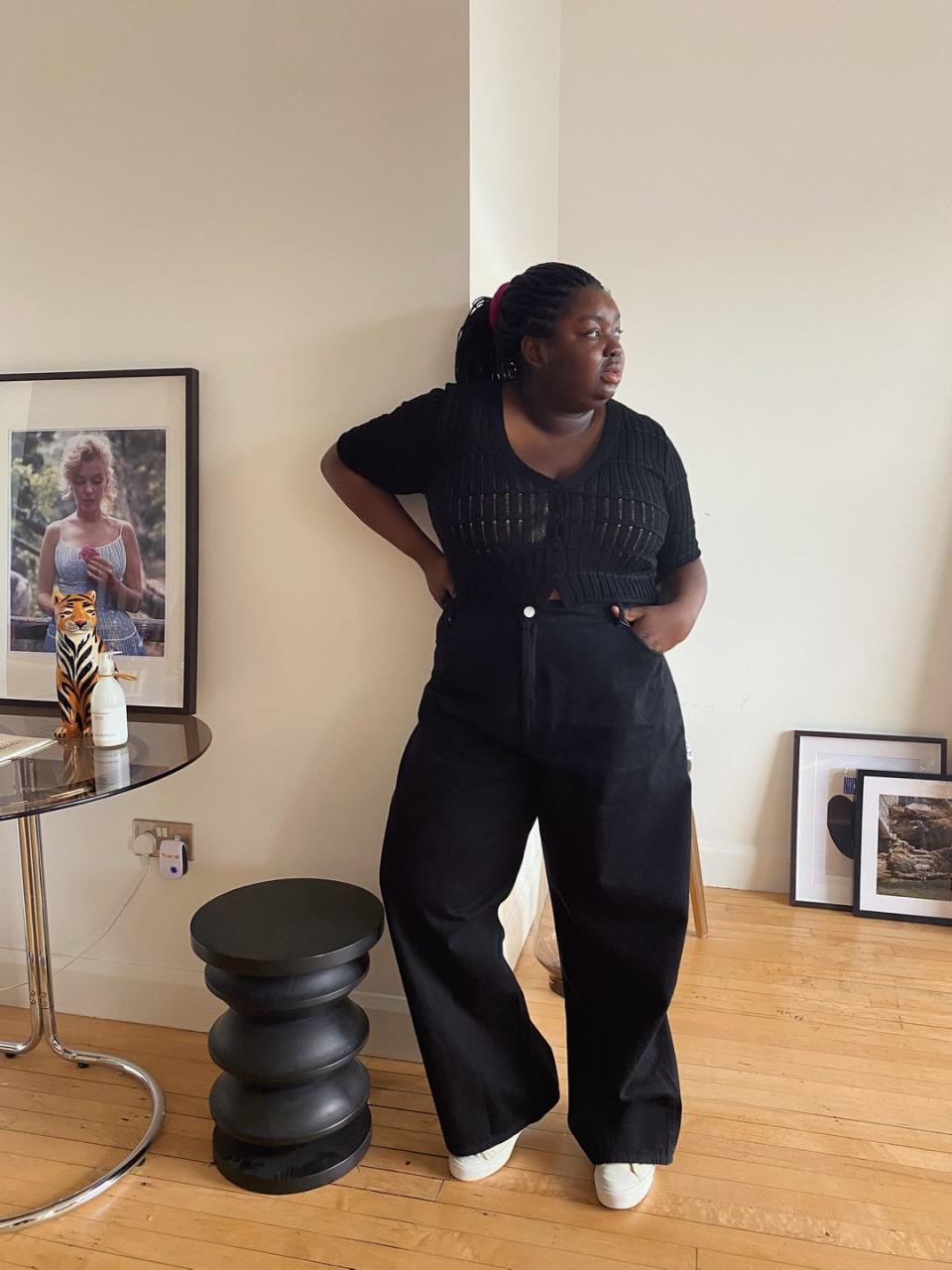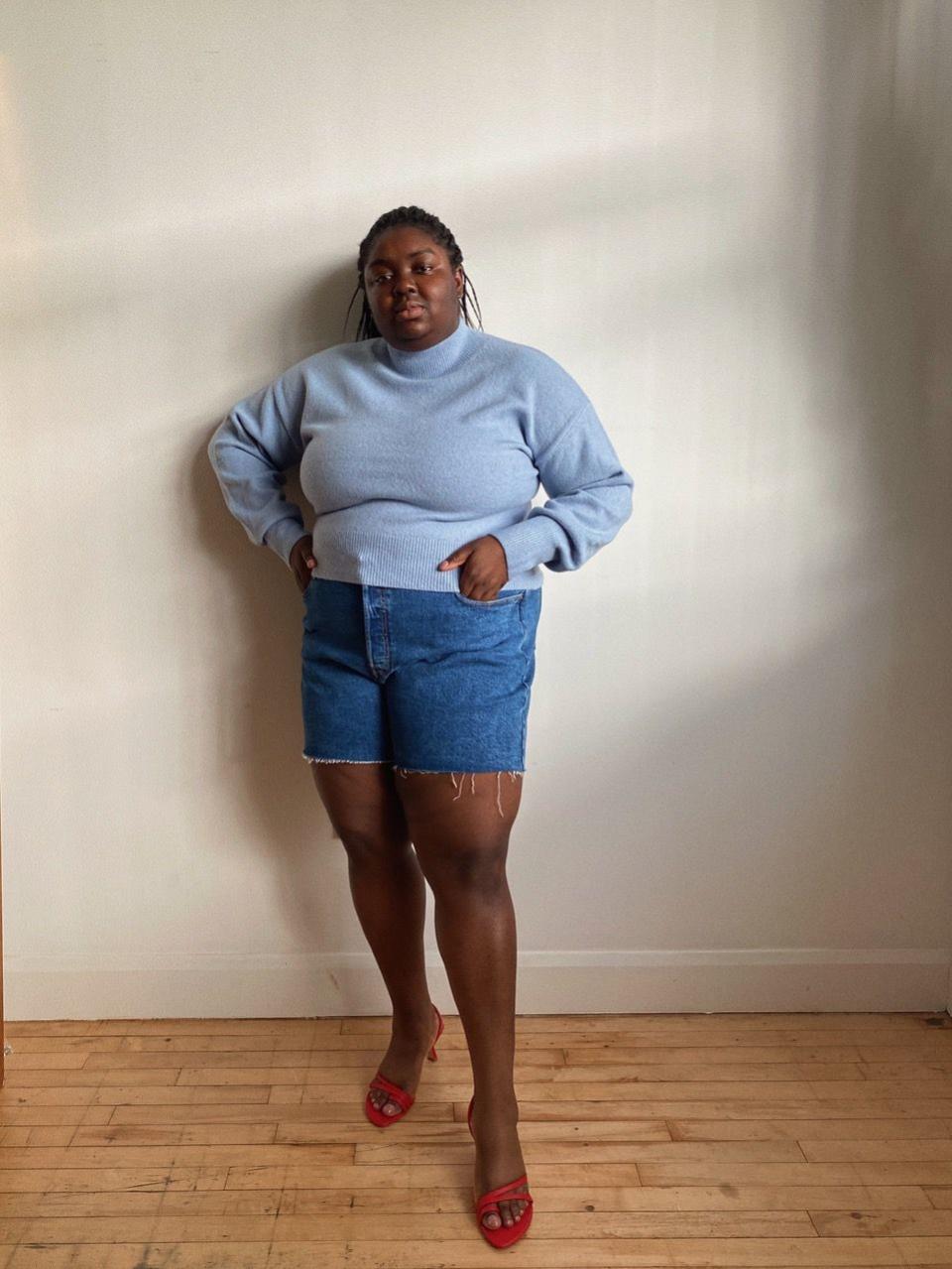Abisola Omole Makes Plus-Size Fashion Work for Her—in Spite of Industry Failings

Last year, I was in New York for a big event that was being hosted by one of the biggest jewelry brands in the world. I landed at JFK a couple days before all the festivities were due to start, which was perfect because I had big plans to spend a whole afternoon in one particular store. It had just announced its foray into “extended sizing.” and with my birthday less than a week away, I was ready to spend some serious money.
The day after I landed, I left my Lower East Side hotel and headed out to the store on Howard Street, buzzing. A sales associate introduced himself and let me know that they don’t always have all the sizing/styles out on the floor and that I should let him know if I needed anything in particular. I thanked him and started to pull pieces off the racks that I wanted him to get in my size. The shop’s extended sizing went up to a US24, so I was confident that I’d find something.
I’m a US14-18 (UK18-22). I’m three sizes, sometimes more. Trying to find clothes in "my size" is honestly hilarious. I basically have to go to a shop and request its biggest sizes, and then work my way down to see what fits. It’s very rare that I can just buy something in a US16 from somewhere and have it be suitable—even though it is technically my size.
Most of America is size 14 or above. According to Plunkett Research. Plunkett Research estimates that 68 percent of American women wear a size 14 or above, while retail analytics firm Edited’s research says only 2.3 percent of the women’s apparel offerings found in large multi-brand retailers, like Net-a-Porter, is plus size. You can’t help but roll your eyes at the blaring hypocrisy and cry out that severe change needs to be implemented.

I took around eight pieces to the associate and requested he bring them all in the two largest sizes. Several minutes later, he returned with a lot of clothing. I gathered a yellow floral dress in my hands, tossed it over my head, and as I started to pull it down, the all-too-familiar feeling of knowing that this was not going to go any further than my shoulders very quickly hit me. I thought, "This isn’t possible. How can it not?" A tightness formed in my chest as I struggled to release myself from the dress. As I went to hang it back up, I realized that the size actually read US12. I can’t lie: I was filled with relief knowing that I was actually trying on a dress three sizes too small.
I checked the other pieces, and they were all a combination of 10s and 12s. I assumed the associate had made an honest mistake. I pushed the button in the changing room to call him back in and explained everything. He responded, "But I did bring you our biggest sizes." I gave him a bewildered look, and then said, "But I thought you now go up to a 24?" He slowly nodded and said, "Oh, you wanted extended sizing. Yeah, we don’t stock those in-store, but you can get them online if you want."
Disappointed, I smiled, thanked the man, and headed back to my hotel, where, yes, I placed an order and decided to get everything in a US20. I thought even if they’re too big, at least I’ll be able to roughly know what size I am.
We’ll discuss the fact that many brands actually making plus-size clothing do not feature the apparel in-store another time. It’s a whole other conversation grounded in the theory that they don’t want plus-size customers physically in their stores. I have found that they don’t prioritize our customer experience, but they still very much appreciate and want to get in on our $21 billion market spend.
A bit about me—I am of Nigerian descent, and I live in London. I run a few companies, arva, a contemporary lifestyle brand; studio arva, an interior styling and design studio; and The Apartment, a creative and digital agency. I’m really into films, hotels, skincare, and, of course, fashion.

To support my businesses, I am active on Instagram, and I’ve amassed a following over the past few years. I have a community on social media that seems to be grounded in love and support. When they can see I’m trying something new or that I’m nervous, the kind words of encouragement I receive in my DMs are somewhat overwhelming and usually bring me to tears. Unfortunately, though, as a woman who wears what’s considered plus size and who loves to shop, that has not always been my experience in real life.
So back to that online order. A few days later in Manhattan, the hotel reception rang, saying I had a package. Shortly after, a bellhop arrived at my door with a big brown envelope-like bag. I couldn’t rip into the package any quicker. Of the eight items I bought, three of them fit. Just three. Bear in mind, I ordered everything in a US20, even though my usual size is a 16. I tried not to dwell on it too much and decided to keep two dresses that I knew I looked great in.
Later that morning, as I got ready for the first event on the jewelry brand’s schedule, I scrapped my original outfit plans and wore one of the dresses that had just arrived: a light brown linen dress that I paired with navy mules and gold-and-amber earrings. Between meeting the rest of the group downstairs and the short 10-minute walk to the store, I must have received eight compliments. I thought all of that stress and worry had paid off. I felt great.
That evening, as I sat at the dinner table among 100 other guests, I couldn’t help but realize that I was the only plus-size person and one of only three Black people present. I noted it, of course, but I started to mingle, enjoy my food, and get to know the other glamorous individuals in attendance.
As a sense of familiarity formed, I dared to ask one of the brand representatives a question, “Why are there no plus-size influencers on this trip. I’m only here because I’m a plus one—isn’t jewelry universal?” To which one of the women, who represents other brands as well, responded, "Yes, of course, it is. But honestly, Abi, we struggle to find plus-size individuals that really align with the brand." This comment was quickly followed by, "But you look really chic tonight."
And I did, I was wearing a black jumpsuit, paired with a black-and-gold fringe clutch and gold spiral earrings. Amid the sense of rejection I had felt earlier in the week while shopping coupled with now essentially being told that there were no chic or stylish plus-size contenders in the industry, I started to feel uneasy. Put simply, an industry seriously lacking in diversity has the audacity to judge our bodies and to make passing assumptions about our style, without creating any real solutions.
Imagine living in a world where you can see trends, you can see what’s stylish, and you constantly fall in love with pieces that you can’t actually own. You scramble to find ways to re-create looks, while the growth of your personal style is stifled because there are very limited choices available to you.
Then you’re told that it’s surprising that you are stylish, with the hinted assumption that you’re a rare outlier. And many of these "critics" don’t create collections in your size or give you the chance to become part of their communities. The irony is so overwhelmingly frustrating, it’s taken me years to really face it all and to understand that I will have to work extremely hard and spend a lot of time searching for clothes if I am to change perceptions.
Being plus size in 2020 isn’t all bad; I’ll admit that. We have some really great options now, with my personal favorites including Henning, 11 Honoré, Violeta by Mango, Universal Standard, ASOS, and Marks & Spencer (just to name a few). The choices have increased, especially when compared to just five years ago.
My day-to-day style is quite laid back and comfortable, and usually features muted notes and soft fabrics. Comfort is a huge priority of mine. I’d like to think I’m sophisticated and chic. I often have these wild card moments, where I’ll wear something extremely feminine or loud, and, honestly, I love those moments—but not every day.
I'm hoping the industry continues to try to rise to the occasion—but, they can speed it up a little too.
You Might Also Like


